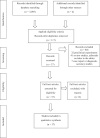Adenovirus 36 prevalence and association with human obesity: a systematic review
- PMID: 33753885
- PMCID: PMC7983349
- DOI: 10.1038/s41366-021-00805-6
Adenovirus 36 prevalence and association with human obesity: a systematic review
Abstract
Introduction: Obesity has numerous etiologies and includes biological factors. Studies have demonstrated that the human adenovirus subtype 36 (Adv36) is an adipogenic agent and causes metabolic alterations. Study results on the prevalence of Adv36 and clinical effects in humans vary substantially. This was a systematic review to summarize the studies on the prevalence of Adv36 infection and its association with human obesity.
Methods: A systematic literature review was conducted using the preferred reporting items for systematic reviews and meta-analysis (PRISMA). Observational or experimental studies found in the Medline, Embase, LILACS, Science Direct and SciELO databases that presented results on the prevalence of Adv36 in humans were included.
Results: Thirty-seven studies were screened. A total of 10,300 adults aged 18-70 years and 4585 children and adolescents aged 3-18 years were assessed. The average prevalence of Adv36 among adults was 22.9%, ranging from 5.5% to 49.8%. Among children and adolescents, the average prevalence of Adv36 was 28.9%, ranging from 7.5% to 73.9%. There was a positive statistical relationship between Adv36 and weight gain, obesity, or metabolic changes in 31 studies. However, in four studies there was no association with obesity, and in one, no association was described. One of the studies showed an inverse correlation, i.e., Adv36 was a protective factor against obesity.
Conclusion: Strong evidence suggested a positive association between viral infection and obesity. However, due to the multi-causality of obesity and heterogeneity of studies, diagnostic tests should be standardized and easily accessible by the population to estimate the overall prevalence of Adv36 infection and its association with obesity.
Conflict of interest statement
The authors declare no competing interests.
Figures


Similar articles
-
The relationship between adenovirus-36 seropositivity, obesity and metabolic profile in Turkish children and adults.Epidemiol Infect. 2015 Dec;143(16):3550-6. doi: 10.1017/S0950268815000679. Epub 2015 Apr 16. Epidemiol Infect. 2015. PMID: 25876626 Free PMC article.
-
Adenovirus 36 and Obesity: An Overview.Viruses. 2015 Jul 8;7(7):3719-40. doi: 10.3390/v7072787. Viruses. 2015. PMID: 26184280 Free PMC article. Review.
-
Adenovirus-36 is associated with obesity in children and adults in Sweden as determined by rapid ELISA.PLoS One. 2012;7(7):e41652. doi: 10.1371/journal.pone.0041652. Epub 2012 Jul 27. PLoS One. 2012. PMID: 22848557 Free PMC article.
-
Human adenovirus-36 and childhood obesity.Int J Pediatr Obes. 2011 Sep;6 Suppl 1:2-6. doi: 10.3109/17477166.2011.590200. Int J Pediatr Obes. 2011. PMID: 21905809
-
ADV36 adipogenic adenovirus in human liver disease.World J Gastroenterol. 2014 Oct 28;20(40):14706-16. doi: 10.3748/wjg.v20.i40.14706. World J Gastroenterol. 2014. PMID: 25356033 Free PMC article. Review.
Cited by
-
Simple Energy Balance or Microbiome for Childhood Obesity Prevention?Nutrients. 2021 Aug 9;13(8):2730. doi: 10.3390/nu13082730. Nutrients. 2021. PMID: 34444890 Free PMC article. Review.
-
Findings from Studies Are Congruent with Obesity Having a Viral Origin, but What about Obesity-Related NAFLD?Viruses. 2021 Jul 1;13(7):1285. doi: 10.3390/v13071285. Viruses. 2021. PMID: 34372491 Free PMC article. Review.
-
The seroprevalence of adenoviruses since 20001.Emerg Microbes Infect. 2025 Dec;14(1):2475831. doi: 10.1080/22221751.2025.2475831. Epub 2025 Mar 17. Emerg Microbes Infect. 2025. PMID: 40035700 Free PMC article. Review.
-
Influence of Seropositivity against Adenovirus-36 on the Risk of Obesity and Insulin Resistance in the Child Population of Southern Chile.Viruses. 2024 Jun 20;16(6):995. doi: 10.3390/v16060995. Viruses. 2024. PMID: 38932286 Free PMC article.
-
The immunology of sickness metabolism.Cell Mol Immunol. 2024 Sep;21(9):1051-1065. doi: 10.1038/s41423-024-01192-4. Epub 2024 Aug 6. Cell Mol Immunol. 2024. PMID: 39107476 Free PMC article. Review.
References
-
- Obesity: preventing and managing the global epidemic. Report of a WHO Consultation (WHO Technical Report Series 894). Authors: World Health Organization. 252. Publication date: 2000. - PubMed
-
- WHO. Obesity and overweight. Updated 16 Feb 2018. Available at: http://www.who.int/news-room/factsheets/detail/obesity-and-overweight. Accessed 5 Jan 2020.
Publication types
MeSH terms
LinkOut - more resources
Full Text Sources
Other Literature Sources
Medical

